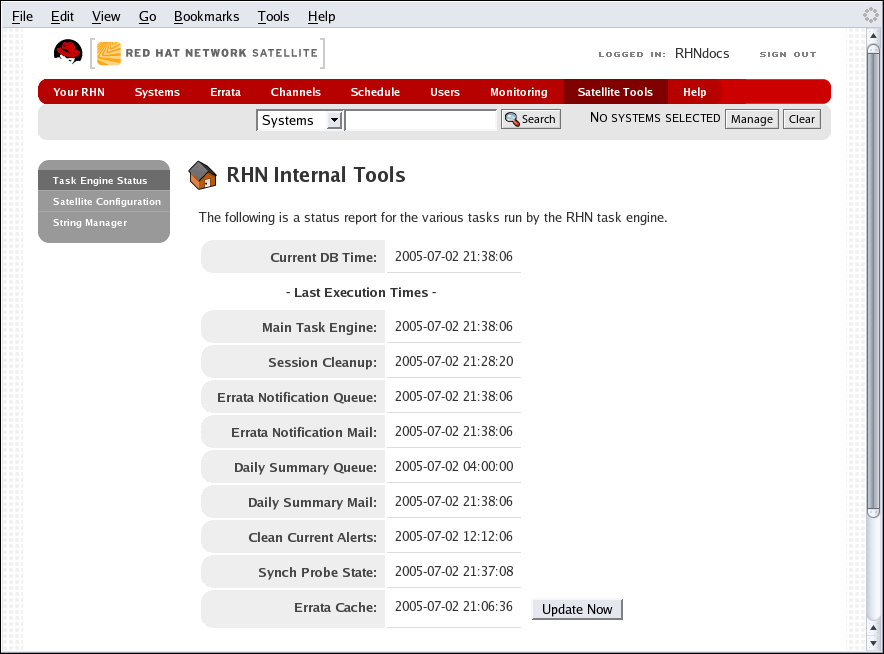此内容没有您所选择的语言版本。
6.11. Satellite Tools
This page allows RHN Satellite Server customers to manage the basic configuration of their Satellite. The default page, Task Engine Status, provides a summary of the latest execution times for key tasks.
Figure 6.22. Satellite Tools
6.11.1. Satellite Tools ⇒ Satellite Configuration
复制链接链接已复制到粘贴板!
This tab is broken down into sub-tabs that allow you to configure most aspects of the RHN Satellite Server. Once changes have been made, it is important to restart the Satellite, which may be accomplished on the final tab.
The Satellite Configuration ⇒ General Configuration page allows you to alter the most basic Satellite settings, such as the admin email address and whether Monitoring is enabled.
The RHN Satellite Configuration ⇒ Monitoring page allows you to configure the monitoring aspects of this Satellite. The local mail exchanger and local main domain are used to mail monitoring notification messages to administration. This is required only if you intend to receive alert notifications from probes. If you do, provide the mail server (exchanger) and domain to be used. Note that sendmail must be configured to handle email redirects of notifications. When finished, click Update Config.
The RHN Satellite Configuration ⇒ Certificate page allows you to either upload a new Satellite certificate. To identify the certificate's path, click , navigate to the file, and select it. To input its contents, open your certificate in a text editor, copy all lines, and paste them directly into the large text field at the bottom. Red Hat recommends using the file locator as it is less error prone. Click to continue. If you receive errors related to DNS, ensure your Satellite is configured correctly.
The RHN Satellite Configuration ⇒ Bootstrap page allows you to generate a bootstrap script for redirecting client systems from the central RHN Servers to the Satellite. This script, to be placed in the
/var/www/html/pub/bootstrap/ directory of the Satellite, significantly reduces the effort involved in reconfiguring all systems, which by default obtain packages from the central RHN Servers. The required fields are pre-populated with values derived from previous installation steps. Ensure this information is accurate.
Checkboxes offer options for including built-in security SSL and GNU Privacy Guard (GPG) features, both of which are advised. In addition, you may enable remote command acceptance and remote configuration management of the systems to be bootstrapped here. Both features are useful for completing client configuration. Finally, if you are using an HTTP proxy server, complete the related fields. When finished, click .
The RHN Satellite Configuration ⇒ Restart page contains the final step in configuring the Satellite. Click the button to restart the Satellite in order to incorporate all of the configuration options added on the previous screens. Note that it will take between four and five minutes for the restart to finish.
